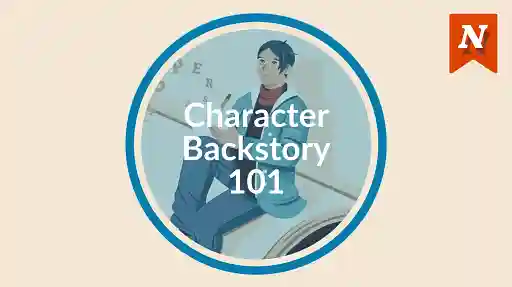Good character flaws are key to a believable character. Flawed characters create suspense - we wonder whether their flaws will get the best of them. The imbalances in their natures may create weaknesses that give others the upper hand. Here are tips to create flaws for antagonists or villains (i.e. characters who stand between your main character(s) and their goals):
1. Create flaws that explain your bad guys' goals
Flaws can be what make a character attractive. Yet here we're focusing on their dangerous aspects.
It's useful to think of flaws as imbalances - qualities a person has out of healthy proportion. Once things are out of proportion, conflict often results. And conflict makes stories suspenseful and engrossing.
An example of an explanatory flaw: Greed. This might explain why your antagonist loves money so much they deceive and con others to gain more. The scheming Uriah Heep in Charles Dickens' coming of age epic David Copperfield (1849) fits this description.
A list of flaws that could explain your antagonist's goals include:
- Greed: Excessive desire for more than what a person rationally needs (power, money, food, control, etc.)
- Jealousy: Envying and wanting what others have
- Prejudice: Holding unfounded beliefs based on surface details about others, e.g. Race, Nationality, Religion, Gender, Orientation etc.
- Sadism: Taking pleasure in the pain of others
- Psychopathy: Suffering from chronic mental disorder with abnormal or violent social behaviour' (Oxford English Dictionary definition)
These are just some of the character flaws that explain antagonists' actions and choices.
Flaws aren't always specific to a single character, either. In a novel like Margaret Atwood's The Handmaid's Tale (1985), prejudice is the flaw and society the antagonist. This is because in Atwood's dystopia, women are reduced to property. Here the flaw - society's troubling ideas about women - explains why they are kept under discriminatory laws.
Creating flaws that explain characters' behaviour ensures your villains or antagonists have clear motivations for their behaviour.

2. Give villains' character flaws history too
Often we focus so much on developing believable protagonists we neglect antagonists. This is a classic trope in thrillers, spy movies and other stories about 'good guys vs bad guys'. Often the hero has a past but the 'bad guy' has little backstory. He's a cardboard villain with an accent who carries an exotic cat. Some genres are, of course, more forgiving of cliches and tropes. Yet a character that has some background is usually more interesting.
Instead, find events in your antagonists' backstories that explain how they became 'bad to the bone'. For example, Tolkien uses Sauron's crushing past defeat in his Lord of the Rings cycle to explain (at least partially) his constant pursuit of power.
After Sauron lost physical form (becoming a terrible eye watching over the land of Mordor), it's easy to understand why this power-hungry warlord would not be content with his situation.
Past experiences that may underlie antagonists' flaws and devious actions may include:
- Trauma: Sometimes people don't rise above personal trauma (a heartbreak, a defeat, etc.), becoming hateful, bitter or vengeful instead
- Corruption: Villains might be corrupted by the unprincipled quest for something allied to their own imbalance: Power, riches, pleasure, influence, status, and so on
- Supernatural phenomena: This is a common cause in the horror genre, of course, where spirit possession and otherworldly reasons for 'turning bad' are familiar tropes or motifs
Whatever your antagonists' motives for conflicting with your main character(s), give them their own origins to make their complete arcs believable, too.
3. Use advantages and disadvantages that come with flaws
Villains, like heroes, have certain advantages because of their flaws, along with disadvantages. A 'fatal flaw', the Achilles' heel that brings a 'bad guy' down, is something that may play into a hero's hands.
For example, in many classic thriller and espionage scripts, the villain talks... and talks ... buying the main character enough time to pull off a stunning coup.
This is a trope that the watchful viewer (or reader) will likely notice as a device, and thus isn't the most effective. Why would a ruthless villain stop when they're close to their goal, after all, to have a long, gloating chat? It seems too foolish.
There are other 'advantage' vs 'disadvantage' pairings you can use, however. For example:
Antagonist flaw: Psychopathy
Advantage (for villain): Fearlessness
Disadvantage (for villain): Unable to form trustworthy connections based on typical human values (e.g. mutual care, empathy). Vulnerable to betrayal by own henchmen or strong opposition from elsewhere due to their violent, unfair or sadistic deeds.
Antagonist flaw: Arrogance
Advantage (for villain): Confident demeanour may help them to control others to do their bidding
Disadvantage (for villain): Confidence may become overconfidence - they wrongly believe themselves to be invulnerable and leave weak points in their defences.
As you can see from these two examples, your antagonist's flaws may help them in some ways, but hinder them in others. Show this double-edged quality and use it to explain how sometimes your antagonists have the upper hand, sometimes your 'heroes' or protagonists.

4. Use good character flaws to build villains' story arcs
Once you've identified good character flaws for your antagonists, use them to build interesting story arcs.
For example, a school bully who physically or emotionally abuses other characters might do so out of insecurity. Perhaps they have a volatile (or bullying) home situation that they're acting out at school. If their flaw is insecurity, show what happens once this imbalance is fed.
There's a story about two wolves fighting that ends with the question, 'Which one wins?' The answer is 'The one you feed.' When you feed antagonists' imbalances, how do they respond? If the power-hungry army leader captures one city, how does it embolden him? Could one small win cause another flaw (fear of disloyalty) flare up, bringing further complications in the character's story arc?
Thinking about antagonists' flaws and imbalances this way - as dynamic, changing and shifting situations - will help you create the development that makes a story gripping.
Need help writing believable characters? Get How to Write Real Characters for help balancing backstory with action and more.
Read more of our top character posts via our character writing hub.









How to write the bad guys
Louisa Bauman - About 7 years ago
Indeed. How to write bad guys? This is a very nice post! Moving. I swear, these posts are sent at the write time. Just whenever I need it. But, how do you portray it? How to make sure you write it, express it for the character and not for the story? Like... How to not force the character? I'd really like to learn how.
Char Midnight - About 7 years ago
Thank you, Char! I'm glad you enjoyed it. And I'm glad the timing is right, too. Use details of showing such as gestures (for example, how does a character with a mean, arrogant streak carry themselves? Perhaps they walk very upright/erect, conveying their confidence). The best thing to do is to just write your characters and ask beta readers if the intended character traits come across. Good luck!
Bridget At Now Novel - About 7 years ago
Think about SHOW and TELL How would you describe the physical body mannerisms of a character that is Greedy? Using their facial expressions and moving their hands or feet? SHOW-Each of these listed below. Greed: Excessive desire for more than what a person rationally needs (power, money, food, control, etc.) Jealousy: Envying and wanting what others have Prejudice: Holding unfounded beliefs based on surface details about others, e.g. Race, Nationality, Religion, Gender, Orientation etc. Sadism: Taking pleasure in the pain of others Psychopathy: Suffering from chronic mental disorder with abnormal or violent social behaviour’ (Oxford
Daniel Agostinelli - About 7 years ago
Hi Daniel, thanks for commenting. Showing is important, that's true. Some of these traits you can convey through narration and story events too, along with physical description (you might suggest a character is greedy through gestures - e.g. rubbing hands together in glee when they see loot of some kind - yet you can also suggest this through the choices they make that are the symptoms of their lust for 'more'). Different ways of looking at the same thing. Thanks for reading!
Bridget At Now Novel - About 7 years ago
I do not mean to be rude, I simply wish to stress my opinion. It can be upsetting for people who are sensitive to, or do have, 'psycopathy' as you called it, or ASPD, (antisocial personality disorder). The majority of them, like any other person, do wish to be loved and cared for. But they are tortured by a mental state, which is often triggered by neglection, abuse and/or emotional suffering of sorts. There have been two people with ASPD that have killed simply so they can talk to the dead bodies. They are lonely beyond belief, and their suffering shouldn't be characterized in a negative way. A minority may do awful things on occasion, but that is deeply influenced by something truly awful. I really do hope you take my words into consideration. Having a mental/personality disorder isn't something to be taken lightly, and writing a character like this as an antagonist would not do anything to help these people feel any better. They might find themselves relating to this character more than you may like, and this could deteriorate their state even more. The majority of them already think that the world is against them, and having an influx of antagonists that are portrayed in the stereotypical assumption of how a 'pyscopath,' acts, would not assist them. Other than that, I found this post extremely helpful. Thank you.
Oriana Silvers - Over 3 years ago
Hi Oriana, thank you for sharing your honest opinion. That is absolutely true, and thank you for bringing a nuanced perspective to this word and its usage. In a story such as a murder mystery, one of the perpetrator's motivations may stem from psychopathy but if a writer were to use this specific condition as a motivating force, I wouldn't say they would be necessarily passing judgment on all people with psychopathic traits (or even the character, they may be portrayed somewhat sympathetically, e.g. Dexter Gordon in the Dexter series, whose own impulse to kill is explained in the course of the story via childhood emotional suffering the way you describe). A wise author will not paint an entire, heterogenous group with one brush, either. This is what leads to a work reading prejudiced and often ends up being what dates it as opinions shift. At some point authors do have to put identity politics to one side, in addition to being sympathetic to them, though. Otherwise nobody could ever write a word if one had to think 'but not all [insert type here] are like that' before giving a character X attribute. If the reader assumes a villain with psychopathic traits stands or speaks for all psychopaths, in other words, that is the reader's choice or sensitivity. However representation does also matter, and authors have a certain responsibility in this many would argue. Thank you for sharing your insight.
Jordan - Over 3 years ago